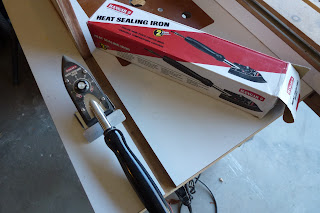Pigments and Dyes Make Stains
 Stains use pigments and/or dyes to produce different effects. In general, pigments will enhance the wood grain and dyes will display the figure in the wood. Used together, your stain application can be one of the highlights of your project.
Stains use pigments and/or dyes to produce different effects. In general, pigments will enhance the wood grain and dyes will display the figure in the wood. Used together, your stain application can be one of the highlights of your project.Pigments are the basis for paints but when they are deluded in a solvent, they will fall into the grain that is characteristic in wood species like oak or ash. The pigment particles are too large to be absorbed into the wood so when you wipe the excess stain off across the grain, a small amount of pigment remains in the grain pores. Most people are disappointed when using pigment stains on maple or birch. The pigment particles are too large to be absorbed into the wood and since these species have minimal grain, little color remains after wiping off the excess stain.
Dyes have smaller particles than pigments and they dissolved into a solvent, so no stirring is required.. The solvents can be water, shellac or mineral oil and their purpose is to carry the dye to the wood and they . Dyes are absorbed into the top layer of the wood and work well with changing the color of most wood species.
Mixing and Matching Wood Stains
So pigment stains will emphasize the wood grain and dyes stains will change the wood color. When do you use pigments or dyes, or both? I typically will always use dye to color the wood, and on occasion, use pigments to emphasize the grain. In my Mission Style post, I first applied a dark pigment to highlight the grain, then followed with a reddish-brown colored dye to color the wood. For my table, I wanted to color the pale cherry veneer to the red color expected from cherry. Applying a red dye allowed me to accelerate the decades required to obtain the natural redness of cherry.
Applying a Pigment
To control my results, I typically use Minwax Gel Stains when applying pigments. In this case, gel is the solvent and the pigment is suspended in the gel. I prefer gel because it provides consistency between applications. And the gel reduces the uneven absorption of stain which causes blotching. Cherry and pine are especially prone to blotching.
If you are pleased with the final results of a gel stain, you can skip the dye application step and go straight to applying a finish. In my case, In my case, I want the gel to fill the grain with a dark or medium brown color. I don't always like the dye color results, so I wait for the gel to dry, and then sand off the wood surface using a 150 grit sandpaper with my orbital sander. I want to leave the pigment in the grain, to I only sand the surface to obtain its original color.
Applying a Dye
So now the wood grain is emphasized, but the wood surface is still the color of the raw wood.












































